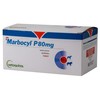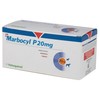Marbocyl P
Marbocyl P Tablets are indicated for the treatment of skin and soft tissue infections (skin fold pyoderma, impetigo, folliculitis, furunculosis, cellulitis), for the treatment of urinary tract infections associated or not with prostatitis, and for respiratory tract infections, caused by susceptible strains of organisms in dogs.
Marbocyl P Tablets 5mg are also indicated for the treatment of skin and soft tissue infections (wounds, abscesses, phlegmons), and upper respiratory tract infections caused by susceptible strains of organisms in cats.
Marbocyl P Tablet 80mg
£3.29Marbocyl P Tablets are used for the treatment of skin and soft tissue infections, for the treatment of urinary tract infections, and for respiratory tract infections in dogs. Each Tablet...[More info]
Marbocyl P Tablet 20mg
£1.10Marbocyl P Tablets are used for the treatment of skin and soft tissue infections, for the treatment of urinary tract infections, and for respiratory tract infections in dogs. Each Tablet...[More info]
Marbocyl P Tablet 5mg
£0.59Marbocyl P Tablets are used for the treatment of skin and soft tissue infections, for the treatment of urinary tract infections, and for respiratory tract infections in dogs. Marbocyl 5mg...[More info]
Dosage and administration
For oral administration. The recommended dose rate is 2 mg/kg per day in a single daily administration. To ensure a correct dosage body weight should be determined as accurately as possible to avoid underdosing.
In dogs for the treatment of skin and soft tissue infections, treatment duration is at least five days. Depending on the course of the disease it may be extended up to 40 days. In urinary tract infections, treatment duration is at least 10 days. Depending on the course of the disease it may be extended up to 28 days. In respiratory infections, treatment duration is at least 7 days and, depending on the course of the disease, may be extended up to 21 days.
In cats for the treatment of skin and soft tissue infections, treatment duration is 3–5 days. For upper respiratory infections, treatment duration is 5 days.
Contra-indications, warnings, etc
Marbofloxacin should not be used in dogs aged less than 12 months or less than 18 months for exceptionally large breeds of dogs, such as Great Danes, Briard, Bernese, Bouvier and Mastiffs with a longer growth period. Not recommended for use in cats aged less than 16 weeks.
Not suitable for infections resulting from strict anaerobes, yeast or fungi.
Do not use Marbocyl P 20mg or Marbocyl P 80mg tablets in cats. For the treatment of this species the Marbocyl P 5mg tablet is available.
Special precautions for use in animals
The fluoroquinolones have been shown to induce erosion of articular cartilage in juvenile dogs and care should be taken to dose accurately, especially in young animals.
The fluoroquinolones are known for their potential neurological side effects; cautious use is recommended in dogs and cats diagnosed as suffering from epilepsy.
A low urinary pH could have an inhibitory effect on the activity of marbofloxacin.
Fluoroquinolones should be reserved for the treatment of clinical conditions which have responded poorly, or are expected to respond poorly to other classes of antimicrobials. Whenever possible, use of fluoroquinolones should be based on susceptibility testing. Use of the product deviating from the instructions given in the SPC may increase the prevalence of bacteria resistant to the fluoroquinolones and may decrease effectiveness of treatment with other quinolones due to the potential for cross resistance.
Adverse reactions (frequency and seriousness)
At the therapeutic recommended dosage no severe side effects are to be expected in cats and dogs. In particular no lesions of the articular joints were encountered in clinical studies at the recommended dose rate.
Mild side effects such as vomiting, softening of faeces, modification of thirst or transient increase in activity may occasionally occur. These signs cease spontaneously after treatment and do not necessitate cessation of the treatment.
Use during pregnancy and lactation
Studies in pregnant rats and rabbits showed no side effects on pregnancy. However, no specific studies have been carried out in pregnant cats and dogs.
Interaction with other medicinal products and other forms of interaction
Fluoroquinolones are known to interact with orally administered cations (Aluminium, Calcium, Magnesium, Iron.) In such cases, the bioavailability may be reduced.
Overdose (symptoms, emergency procedures, antidotes), if necessary
Overdosage may cause acute signs in the form of neurological disorders which should be treated symptomatically.
Withdrawal period(s)
Not applicable
Further information
Pharmacodynamic properties
Marbofloxacin is a synthetic bactericidal antimicrobial belonging to the fluoroquinolone group which acts by inhibition of DNA gyrase. It is effective against a wide range of Gram positive bacteria (in particular Staphylococci, Streptococci) and Gram negative bacteria (Escherichia coli, Salmonella typhimurium, Citrobacter freundii, Enterobacter cloacae, Serratia marcescens, Morganella morganii, Proteus spp, Klebsiella spp, Shigella spp, Pasteurella spp, Haemophilus spp, Moraxella spp, Pseudomonas spp, Brucella canis) as well as Mycoplasma spp.
Marbofloxacin is not effective against anaerobes, yeasts or fungi.
Resistance to fluoroquinolones occurs by chromosomal mutation with three mechanisms: decrease of the bacterial wall permeability, expression of the efflux pump or mutation of the enzymes responsible for molecule binding. No significant evolution of resistance to marbofloxacin has been observed in the target pathogenic strains isolated from companion animals since the launch of the molecule on the veterinary market. The occurrence and rate of transfer of a genetic resistance is therefore considered to be very low.
Cross-resistance with ß-lactam antibiotics, aminoglycosides, tetracyclines, macrolide and polypeptide antibiotics, sulfonamides, diaminopyrimidines, and nitrofurans does not generally occur. However, certain mutations conferring resistance to fluoroquinolones can also confer resistance to cephalosporins, tetracyclines, macrolides and chloramphenicol.
Pharmacokinetic properties
After oral administration in dogs and cats at the recommended dose of 2 mg/kg, Marbofloxacin is readily absorbed and reaches maximal plasma concentrations of 1.5 µg/ml within 2 hours. Its bioavailability is close to 100%. It is weakly bound to plasma proteins (<10%), extensively distributed and in most tissues (liver, kidney, skin, lung, bladder, digestive tract) it achieves higher concentrations than in plasma. Marbofloxacin is eliminated slowly (t1/2β= 14h in dogs and 10h in cats) predominately in the active form, in urine (2/3) and faeces (1/3).


